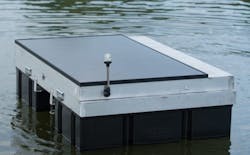Countering Blue Green Algae Blooms with Ultrasonic Solutions
About the author:
George Hutchinson is the co-founder and CTO of WaterIQ, an algae mitigation company specializing in ultrasonic solutions that reduce or eliminate the need for chemicals for algae control.
It is estimated that some 30 million to 48 million Americans get their drinking water from lakes and reservoirs that could be periodically contaminated by algal toxins. Unfortunately, boiling water contaminated by a harmful algal bloom (HAB) does not remove toxins, but instead increases the concentration levels, according to the National Resource Defense Council (NRDC).
The NRDC also notes that the economic toll of HABs in the U.S. has yet to be fully assessed with estimates suggesting the cost of managing freshwater blooms to be $4.6 billion annually. These events often negatively affect local economies as persistent algal blooms typically cost millions in lost tourism revenue, while negatively impacting the residential water supply.
Biologically speaking, blue-green algae — also called cyanobacteria — film is literally the definition of scum, and this is not without cause. As cyanobacteria increases during the spring and summer months across tens of thousands of lakes, reservoirs, ponds and managed wastewater repositories, cities and utilities are under pressure to institute measures that mitigate this problem.
After decades of trial and error, it is now known that chemicals in use to treat algae blooms can be detrimental to wildlife and algal variants. But if not chemicals, then what? Left untreated, algae present health threats, damages to infrastructure, lower property values, and the end of revenue generating recreational pursuits. To understand the alternatives to chemical treatment, a basic understanding of what factors cause algae to thrive is important.
What Makes Algae Blooms Thrive?
Algae requires sunlight and nutrients such as phosphorus and nitrogen to proliferate.
The primary sources of nutrients are farm fertilizer runoff, over-fertilization of lawns, phosphate-based cleaning detergents and surfactants, and overuse of algaecides (particularly copper sulfate). The latter is not intuitively obvious until you realize that overuse of copper causes death to not only algae, but to good beneficial bacteria that are necessary to help remove the excess phosphates that drive the algae growth.
The remaining bacteria unaffected by the copper are mostly anaerobic and found in the muck such as Actinomyces, also responsible for many of the odors such as the distinctive sewer smell, Methyl-Isoborneol (MIB). Over time they cause the algae problem to spiral out of control by continually recycling phosphates back into the water column.
Cyanobacteria feed on the phosphates expelled by anaerobic bacteria and have the ability to create complex hydrocarbons that are toxic to humans and many other animals that have access to the above-mentioned lakes, reservoirs, etc.
Cyanobacteria photosynthesizes like plants and has similar requirements for sunlight, nutrients and carbon dioxide to grow and produce oxygen. There are many different varieties which are typically a green or blue-green color.
However, different varieties can also be white, brown, blue, yellow-brown, or red. Depending on the environmental conditions, cyanobacteria can increase to excessive levels and form visible ‘blooms’ which can lead to poor water quality and the potential for toxicity. Cyanobacteria is well-known to disrupt drinking water supplies, recreational activities, and water-dependent industries, and presents risks to humans, pets/livestock, and a wide range of wildlife.
Remediation Options for Harmful Algae Blooms
Returning to available treatment alternatives to chemicals, managing nutrient levels is an important process in the short- and long-term reduction of harmful algae blooms. This means regular testing of all influents and sections of the water body to determine the source, after which remedies can be applied.
While every water body is unique with its own influents and ecosystem, it is becoming increasingly evident that a holistic approach that involves both nutrient and algae control can be very effective at providing a rapid, long-term solution to the problem. In addition to reducing the nutrient levels, ultrasonic technology and good green algae are important tools to consider when there is a need to rapidly reduce algae levels.
Spearheading the effort in many HAB mitigation efforts are next-generation ultrasonic algae mitigation systems. These are the most advanced platforms available for countering algae blooms, far exceeding the capabilities of earlier models.
New systems have the ability to transmit over 2,000 frequencies to ensure proper and effective resonance is applied to either rapidly growing or well-established algae blooms. The applied frequencies emit ultrasonic sound waves which travel through the water only and cause structural and fatal damage to the targeted blooms.
What experts have learned through careful observation is that a wide frequency range proves effective in treating most algae. The latest generation systems are now autonomous and do not require land-based power. Units are now equipped with solar energy to power all onboard systems.
In addition to the frequency output of an ultrasonic anti-algae system, the mechanical design of the most advanced systems incorporates scientifically significant materials such as algae repellant surfaces. The surfaces of these systems reduce the chance of biofouling which can then reduce their effectiveness. The teams managing these systems typically spend hundreds or thousands of hours studying algae, empirically understanding the ultrasonic frequency ranges. Their knowledge and experience are critical as it is necessary for the most effective placement of these appliances. This is because different waterbodies have differing requirements, based on temperature, depth, shape, size, algae types, etc.
It has been estimated that approximately 95% of the 70,000 species and two million sub-species of algae are affected by ultrasonic systems. As a result, the latest ultrasonic solutions have been shown to be effective and offer a safer way to eliminate harmful algae variants. Most often, this technology will prevent an algae bloom from growing and becoming a problem. As part of a holistic suite of solutions and processes, they are very effective at rapidly remediating the most troublesome cyanobacteria/blue-green algae blooms.


